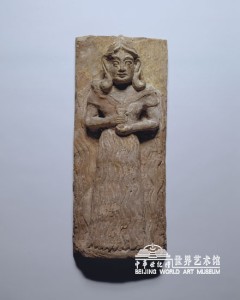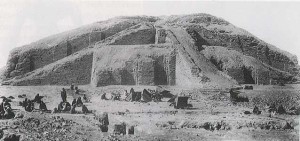Translated by Theo. G. Pinches
This short inscription of twenty-seven lines is one of peculiar interest. It is a record, written in the Akkadian language, of an endowment, made by an early Mesopotamian king with a Semitic Babylonian name, to the great temple at Erech called Ê-ana; and it is not an original, but a copy in clay, written by a man named Nabû-baladhsu-igbî, of a stone tablet kept, in ancient times, in the great temple known as Ê-zida, now the ruin called the Birs-i-Nimroud—the supposed tower of Babel. Great care has been taken by the copyist in inscribing the tablet; and the forms of the characters, as he has given them, probably reproduce fairly well the archaic style of the original. The text itself covers the greater part of the two sides of the clay tablet, which is, like most of the documents of this kind found in Babylonia and Assyria, flat—or nearly so—on the obverse, and curved on the reverse. The last three lines, which are separate from the others, are written smaller, and are in the later Babylonian style of writing. Unlike the rest, also, they are written in the Semitic-Babylonian language. The size of the tablet is 4¼ inches by 2⅜ inches, the thickness in the thickest part being 1⅛ inch. The colour is a very light yellow ochre.
As the word-order in Akkadian differs considerably from English, no attempt is made to preserve the divisions of the lines of the original; by this arrangement translations from these ancient tongues are much more easily understood.
(Texts: All Artifacts, Color Coding, & Writings in Bold Type With Italics Inside Parenthesis, are Added by Editor R. Brown, not the Authors, Translators, or Publishers!)
(gods in blue …mixed-breed demigods in teal…)
Sin-gashid, king of Erech (Uruk), king of Amnanum,
and patron of Ê-ana (Anu’s temple residence in Uruk),
 (Ninsun, spouse to mixed-breed Lugal-banda)
(Ninsun, spouse to mixed-breed Lugal-banda)
to Lugal-banda (Ninsun‘s spouse) his god and Nin-gul (Ninsun) his goddess.
When he built Ê-ana he erected Ê-kankal the house which is the seat of the joy of his heart.
During his dominion he will endow it with 30 gur of wheat, 12 mana of wool, 10 mana of produce,
18 qa of oil according to the tariff, and 1 shekel of gold.
May his years be years of plenty.
COLOPHON IN SEMITIC-BABYLONIAN:
Copy of the tablet of ûsû-stone, the property of Ê-zida, which Nabû-baladhsu-igbî, son of Mitsirâa, has written.
_________
The text begins with an invocation to Lugalbanda and his consort Nin-gul (Ninsun), who seem to have been Sin-gashid’s patron god and goddess. He then speaks of Ê-ana, one of the great temples of Erech (which was, perhaps, Sin-gashid’s capital), and Ê-kankal, probably one of the shrines in Ê-ana. Judging from the wording, Sin-gashid seems to claim to be the founder of both those fanes, though it is probable that he only rebuilt them. Sin-gashid then gives a list of the amounts of produce, etc., with which he had endowed the shrine, and ends with a pious wish for his country. The date of the original of this inscription may be set down at about 2600 B.C. The copy which has come down to us, however, probably dates from the time of the antiquarian revival in Babylonia during the reign of Nabonidus, father of Belshazzar.
It is to be noted that the inscription is dedicated to a god and a goddess whose names I provisionally transcribe as Lugal-banda (“powerful king,” or “king of youthful strength”) and Nin-gul his consort (as we learn from the second volume of the Cuneiform Inscriptions of Western Asia, pl. 59, ll. 24 and 25). This identification of Ningul as the consort of Lugal-banda is important, as it shows that Sin-gashid, who calls her his mother, and himself her son, did not mean to imply that she was his real earthly parent, but that he simply traced his descent from her, thus asserting his divine origin. The late George Smith’s double-queried “Belat-sunat” (as he transcribed the name Nin-gul), “the earliest known queen in the Euphrates valley,” must therefore be erased from the list of historical rulers in Erech.
The temple Ê-ana was probably the principal fane in the city of Erech, and Ê-kankal3 was probably one of the shrines within it. It is not improbable that the Ê-kankal mentioned here is the same as, or the fellow-shrine to, the Ê-ghili-ana mentioned by Assur-bani-pal as the sanctuary, apparently in or connected with Ê-ana, to which he restored the image of the goddess Nanâ (Inanna), which was carried off by the king of Elam, Kudur-nankhundi, about 2,280 years before Christ. As the date of Sin-gashid is doubtful, it is impossible to say with certainty whether the capture of the image of Nanâ by the Elamites took place before or after his reign, but it was probably after.
The inscription here translated and explained is a duplicate of one published in the fourth volume of the Cuneiform Ins. of W. Asia, pl. 35, No. 3, from two cones from Warka. Of this text, which is rather roughly written, and which gives a few interesting variants from the text translated above, a tentative translation was given by the late George Smith in his “Early History of Babylonia,” published in the Transactions of the Society of Biblical Archæology, vol. i., and in the first series of the Records of the Past, vol. iii.
